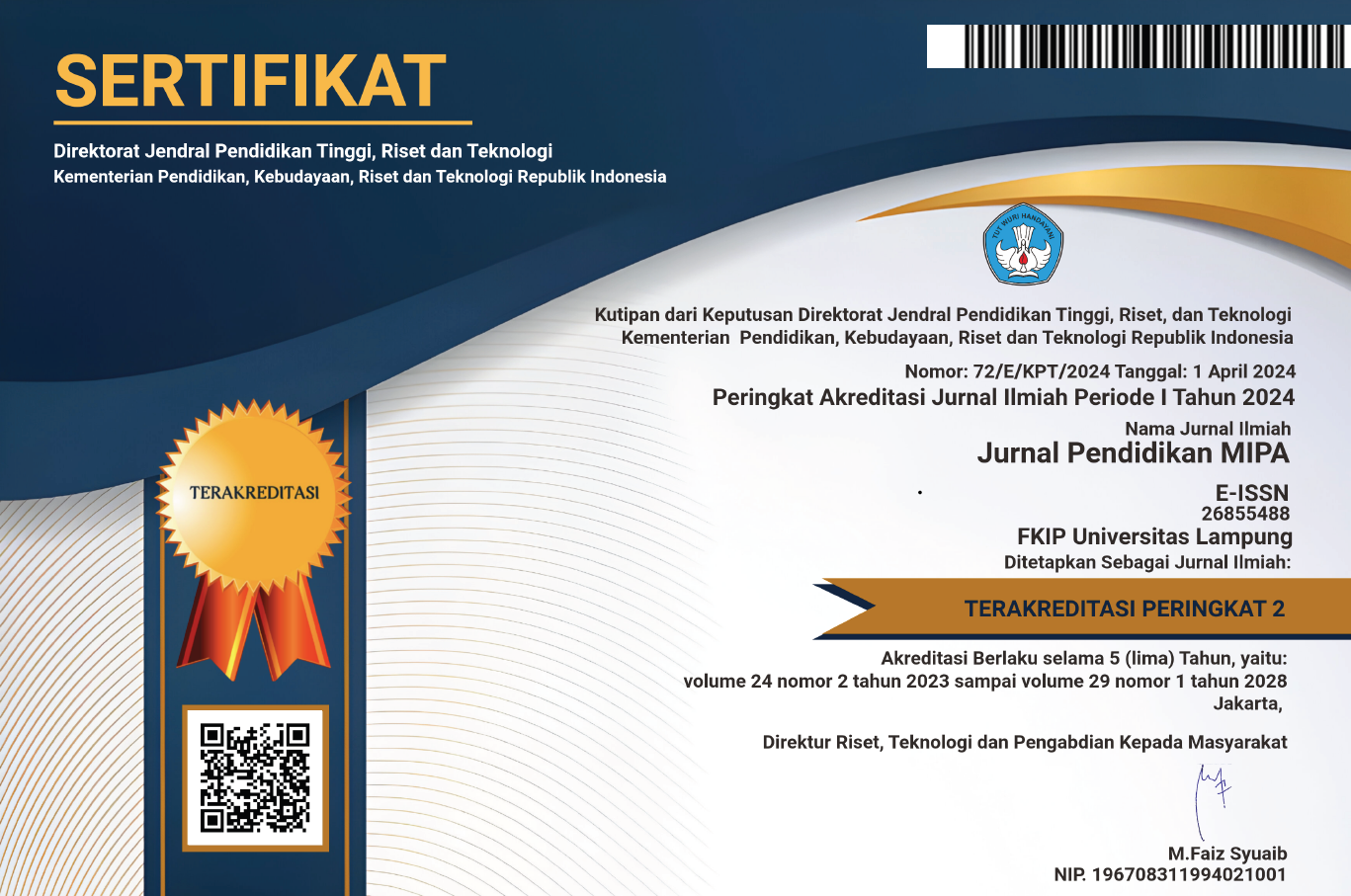The Impact of STEM Acitivities on Computational Thinking Skills: A Case of Pre Service Elementary School Teachers in Universitas Lampung
 Country:
Country:
(1) Universitas Lampung, Indonesia
(2) Universitas Lampung, Indonesia
(3) Universitas Lampung, Indonesia
(4) Universitas Lampung, Indonesia
The research purpose was to implement of the STEM 4.0 approach in improving student CT. This study used a quasi-experimental design with one group pretest - posttest design. The learning integrated 4 STEM components to improve students’ CT. Participants were elementary school teacher education students at state universities in Lampung Province. The test instrument is at the cognitive level C4 and C6 which refers to Bloom's Taxonomy. Based on research data, it is stated that in learning with the STEM 4.0 approach, there are activities to understand the concept of learning material (Science) by integrating everyday life phenomena (Mathematics) and supported by learning media (Technology). Furthermore, there are learning activities in the form of practice activities in solving a problem in groups and making simple products by applying the concepts contained in the learning materials. Through this treatment, CT participants increased with male CT participants being higher than female.
Keywords: computational thinking, STEM approach, pre-service elementary school teacher.
Berland, M., & Wilensky, U. (2015). Comparing virtual and physical robotics environments for supporting complex systems and computational thinking. Journal of Science Education and Technology, 24(5), 628–647.
Conklin, J. (2005). A taxonomy for learning, teaching, and assessing: A revision of Bloom’s taxonomy of educational objectives complete edition. JSTOR.
Council, N. R. (2000). Inquiry and the national science education standards: A guide for teaching and learning. National Academies Press.
Feldhausen, R., Weese, J. L., & Bean, N. H. (2018). Increasing student self-efficacy in computational thinking via STEM outreach programs. In Proceedings of the 49th ACM Technical Symposium on Computer Science Education (pp. 302–307).
Fraenkel, J. R., Wallen, N. E., & Hyun, H. H. (2012). How to design and evaluate research in education.
Junaidi, A. (2020). Perguruan tinggi unggul dan SOTK Kemendikbud (pp. 1–21).
Krajcik, J. S., & Blumenfeld, P. C. (2006). Project-based learning. na.
Lee, I., & Malyn-Smith, J. (2020). Computational thinking integration patterns along the framework defining computational thinking from a disciplinary perspective. Journal of Science Education and Technology, 29(1), 9–18.
Psycharis, S., & Kallia, M. (2017). The effects of computer programming on high school students’ reasoning skills and mathematical self-efficacy and problem solving. Instructional Science, 45(5), 583–602.
Psycharis, S., & Kotzampasaki, E. (2019). The impact of a STEM inquiry game learning scenario on computational thinking and computer self-confidence. Eurasia Journal of Mathematics, Science and Technology Education, 15(4), em1689.
Román-González, M., Pérez-González, J.-C., & Jiménez-Fernández, C. (2017). Which cognitive abilities underlie computational thinking? Criterion validity of the Computational Thinking Test. Computers in Human Behavior, 72, 678–691.
Román-González, M., Pérez-González, J.-C., Moreno-León, J., & Robles, G. (2018). Extending the nomological network of computational thinking with non-cognitive factors. Computers in Human Behavior, 80, 441–459.
Schwarz, C. V., Passmore, C., & Reiser, B. J. (2017). Helping students make sense of the world using next generation science and engineering practices. NSTA Press.
Shute, V. J., Sun, C., & Asbell-Clarke, J. (2017). Demystifying computational thinking. Educational Research Review, 22, 142–158.
Wang, H.-H., Moore, T. J., Roehrig, G. H., & Park, M. S. (2011). STEM integration: Teacher perceptions and practice. Journal of Pre-College Engineering Education Research (J-PEER), 1(2), 2.
Weintrop, D., Beheshti, E., Horn, M., Orton, K., Jona, K., Trouille, L., & Wilensky, U. (2016). Defining computational thinking for mathematics and science classrooms. Journal of Science Education and Technology, 25(1), 127–147.
Wing, J. M. (2006). Computational thinking. Communications of the ACM, 49(3), 33–35.
Wing, J. M. (2008). Computational thinking and thinking about computing. Philosophical Transactions of the Royal Society A: Mathematical, Physical and Engineering Sciences, 366(1881), 3717–3725.
Refbacks
- There are currently no refbacks.

This work is licensed under a Creative Commons Attribution-ShareAlike 4.0 International License.






